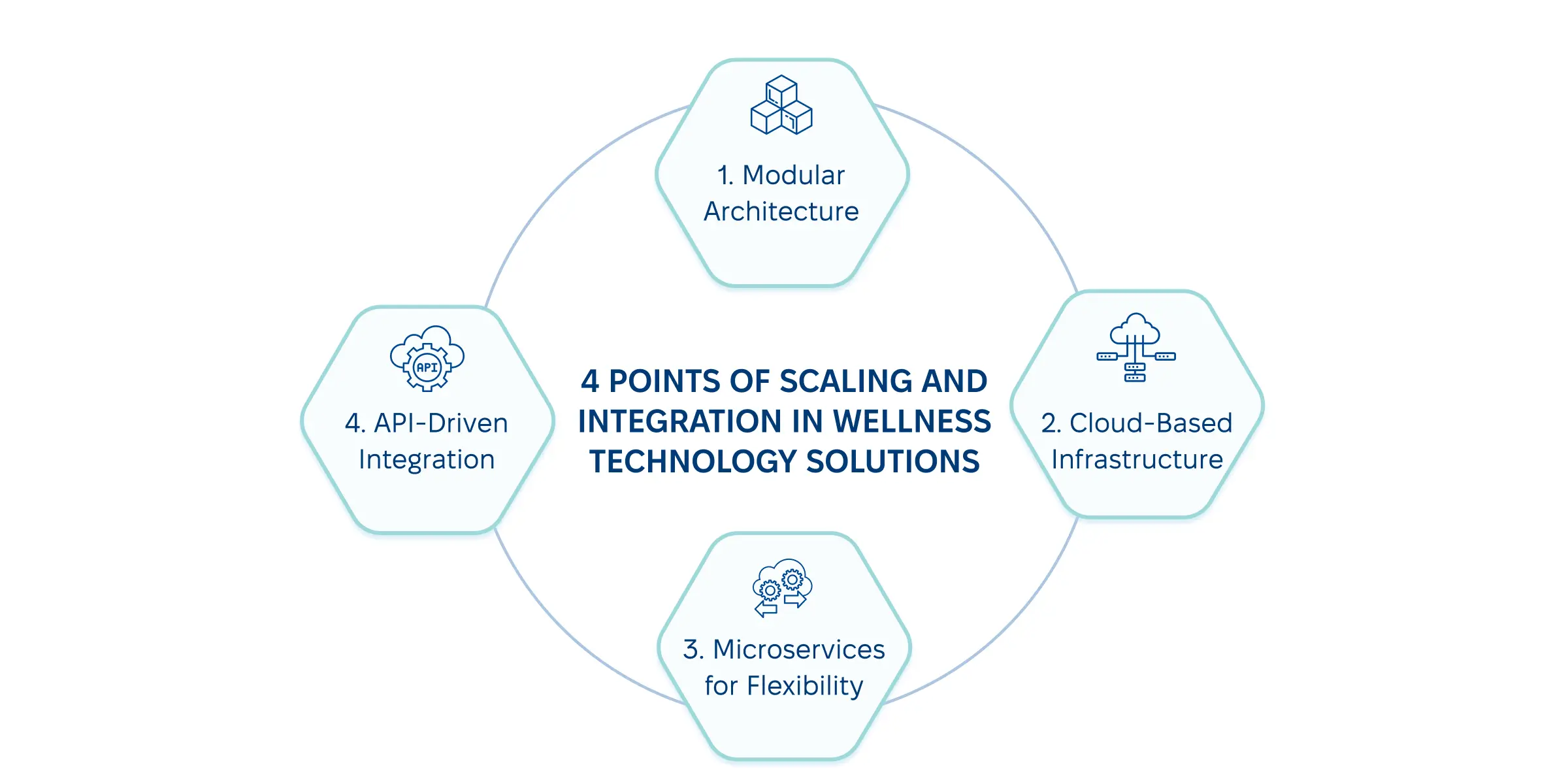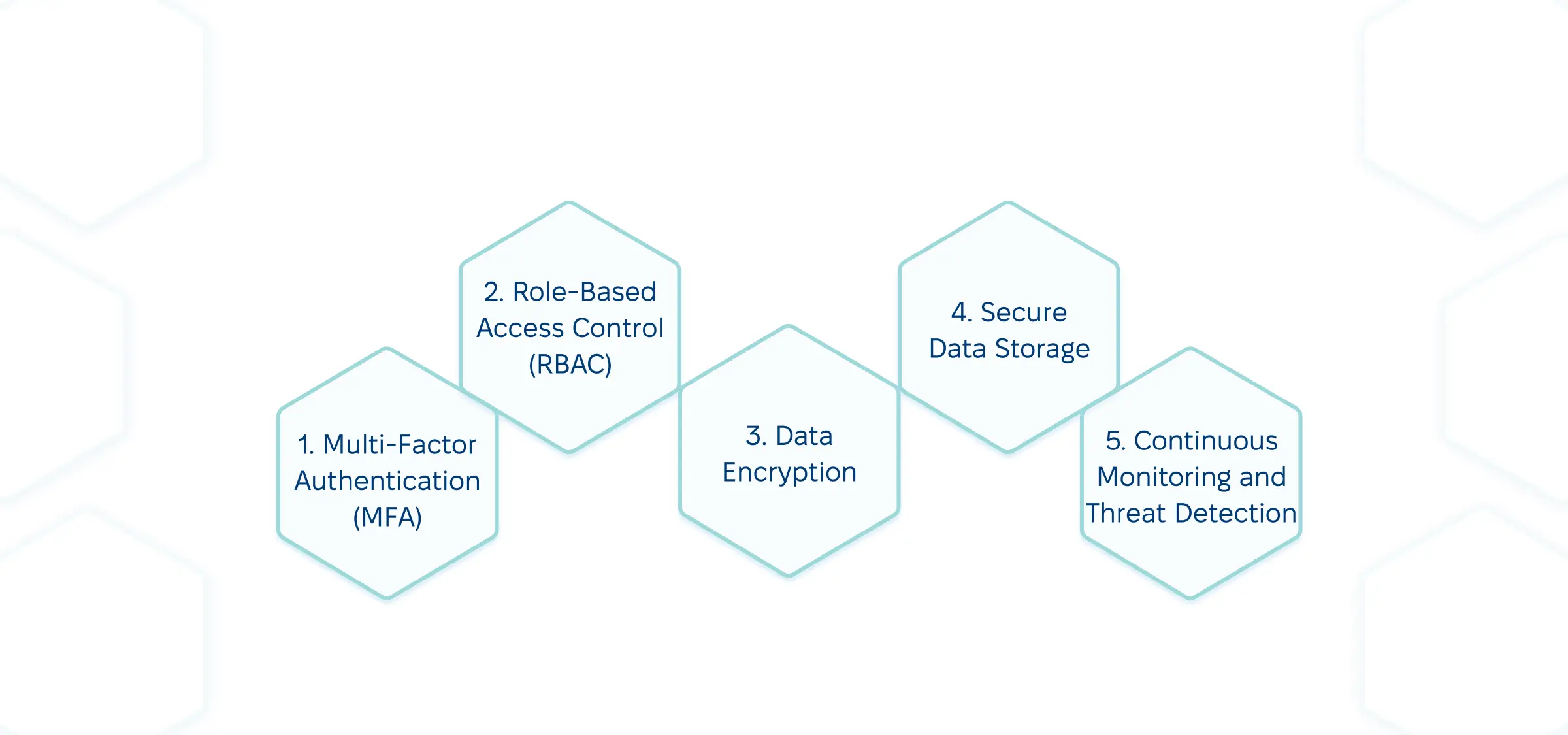Busy schedules make it difficult for modern consumers to stick to healthy habits. That’s why they rely on digital wellness solutions. Simple, consistent, user-centered, and accessible, these applications help manage and track users’ workouts, nutrition, sleep quality, and mindfulness sessions. Wellness solutions integrate with wearable devices, support AI analytics, and offer customization options. They also require baseline technology practices: MFA, role-based access, data encryption, continuous monitoring, and notifications. In our blog post, we go into detail about these tech aspects of wellness platforms.
Wellness tech solutions are growing in popularity. For example,
the global digital health and wellness market
will grow from USD 335 billion in 2022 to over USD 1.1 trillion by 2028. Companies entering
this dynamic market face a unique set of challenges.
Today's users demand platforms that offer convenience, robust data security, and seamless integration
with their daily lives. However, developing these solutions requires a careful balance between
ensuring data privacy and creating engaging user experiences. These points have a significant
impact on how technology enhances wellness.
At Exoft, we understand these challenges firsthand.
Our solutions
improved patient outcomes and demonstrated the power of innovative wellness tech solutions to deliver both personalization and scalability, including our custom wellness solutions that cater to unique user needs.
This article will help you navigate the complexities of designing wellness solutions that resonate
with users by providing a seamless blend of technology, user-centered design, and data security.
Designing for Optimal User Engagement
Creating engaging and intuitive user interfaces is crucial to the success of any wellness
product design. With our Fitness & Wellness App Development Services, we create products
that are useful, visually appealing, and accessible. Users want to focus on their wellness
goals, not deciphering complex app interfaces.
For wellness technology to succeed, it must prioritize:
- Simplicity and Clarity.
Our process
in wellness product development focuses on eliminating unnecessary elements and streamlining
the user journey. By removing distractions and prioritizing key actions, we ensure users
can focus on what matters — improving their health and well-being
- Consistency Across Platforms.
Maintaining uniformity in visual elements such as buttons, typography, and layout creates
familiarity, making the interface feel natural to users. Whether web, mobile, or wearable
tech devices, design ethos ensures that users have a cohesive experience, no matter how they
interact with the product.
- User Feedback and Responsiveness.
Wellness apps require features that respond to user actions, such as confirmation messages
or visual cues. Users feel more connected and engaged with the platform that offers immediate
visual or auditory responses.
- User-Centered Design.
Conducting user research is essential to understanding behaviors, pain points, and needs.
Then, iterate on design based on real-world feedback, ensuring that digital wellness solutions
meet user expectations.
- Accessible Solutions.
Wellness product innovation must be usable by everyone, regardless of ability. Accessibility
goes beyond visual elements, including designing for those with visual impairments, motor
challenges, or cognitive limitations. Features such as adjustable text sizes, screen reader
compatibility, and intuitive navigation structures ensure that wellness apps provide a positive
experience for all users.
In the wellness industry, staying ahead requires a design that resonates with users, keeps
them engaged, and provides seamless access to the necessary wellness resources. At Exoft, we pride ourselves on being at the forefront of wellness product innovation, offering wellness software development solutions that combine cutting-edge technology with user-centered design.
Prioritizing Data Security in Wellness Tech Slutionso
Wellness platforms collect and process sensitive personal health data, making them prime
cyberattack targets. By the way,
the size of the global cybersecurity industry will increase
from $173.5 billion in 2022 to $266.2 billion in 2027. Data protection in medicine will also
grow.
To create a secure wellness tech solution, it's important to implement multiple layers of security
measures. These practices address the core challenges in safeguarding data, such as unauthorized
access, data breaches, and regulatory non-compliance.
Here are the essential practices for any wellness technology platform:
- Multi-Factor Authentication (MFA).
You can ensure that only authorized users can access sensitive data by requiring multiple
verification forms (such as passwords and biometrics). This extra layer of security reduces
the risk of compromised accounts, even if one authentication method is breached.
- Role-Based Access Control (RBAC).
In wellness platforms, not all users need the same data access level. Implementing RBAC allows
you to assign specific access permissions based on a user's role. It minimizes the risk of
data misuse by restricting access to sensitive information to only those who need it for
their roles.
- Data Encryption.
Encrypting sensitive health data ensures that even if data is intercepted or stolen, it remains
unreadable to unauthorized parties. Strong encryption protocols, such as AES (Advanced Encryption
Standard), should be used to secure communications between users, devices, and servers.
- Secure Data Storage.
Data should be stored in environments resistant to unauthorized access and breaches. It includes
using secure cloud services for healthcare data that comply with industry regulations, like
HIPAA. In addition, regular backups and secure data recovery plans should be in place to
protect against data loss.
- Continuous Monitoring and Threat Detection.
Wellness platforms should incorporate tools that monitor user behavior, system activity,
and access patterns. It enables early detection of potential threats, allowing companies
to respond promptly and mitigate security risks before they escalate.
At Exoft, we specialize in developing wellness software that powers a seamless wellness platform, focusing on data security.
Our team has extensive experience implementing cutting-edge security features,
including integrating IoT devices, AI-driven analytics, and secure data storage.
Scaling and Integration in Wellness Tech Solutions
As technology in wellness evolve, scaling and integrating these platforms become vital for
ensuring long-term growth and success. Whether you're developing a training app, mental
health platform, or comprehensive wellness solution, scaling and integrating effectively
is crucial for maintaining system performance.

- Modular Architecture.
By breaking down your platform into smaller, independent modules, you can add new features, services, or user functionalities without overhauling the entire system, supporting the ongoing
modernization in technology for seamless growth.
This architecture ensures that your system can grow seamlessly as user demand increases, creating a flexible wellness solution that adapts to evolving needs.
- Cloud-Based Infrastructure.
Using scalable cloud platforms such as Microsoft Azure or AWS ensures you can adjust resources
in real time as your user base expands. This scalability allows you to handle sudden spikes
in traffic, such as during peak usage periods, without compromising performance.
- Microservices for Flexibility.
Unlike monolithic systems, microservices allow different components of a wellness platform
to function independently. It makes deploying updates, adding new features, or scaling specific
platform parts easier without affecting the entire system.
- API-Driven Integration.
API-driven integration ensures that different systems can communicate with each other in
real time. For instance, integrating wearables like fitness trackers with a wellness platform
allows for continuously sharing health metrics such as heart rate, activity levels, and sleep
patterns.
In our experience, wellness solutions greatly benefit from this approach. Each
service—whether it's user authentication, health data tracking, or scheduling—can be
scaled independently, enabling the platform to handle high levels of user interaction
while maintaining efficiency.
How to Make an Informed Decision?
When building wellness products, making an informed decision requires a comprehensive
evaluation of the available options. Here's a detailed comparison to help guide your
decision-making process:
Feature Comparison
Technology in wellness comes with various features tailored to different market needs. To
make an informed choice, comparing features based on the specific goals you aim to achieve
is essential. When comparing wellness technology trends, ask yourself:
- Does it offer integration with wearable devices for real-time health data?
- Are there AI-driven analytics to provide personalized insights?
- How customizable is the solution to meet both user preferences and business needs?
- Can it integrate with existing systems like EHRs or telemedicine platforms?
Choosing a feature-rich platform that aligns with your goals and the latest
medtech trends,
as well as partnering with a wellness solution company that understands your needs, will set the foundation for success.
Cost Analysis
The cost of implementing tech wellness can vary widely, depending on the complexity of the
platform, customization needs, and ongoing maintenance. It's important to weigh both
short-term and long-term expenses when comparing costs.
- Initial Development Costs.
It includes the upfront costs of developing or customizing the platform. A fully custom solution
will be more expensive but tailored to your needs. Off-the-shelf solutions might be cheaper
initially but may lack the flexibility you require.
- Subscription or Licensing Fees.
Many platforms operate on a subscription basis, especially SaaS wellness solutions. Compare
the recurring fees associated with different solutions and evaluate if they fit within your
budget.
- Maintenance and Support Costs.
Ongoing support and updates are crucial for keeping your platform secure and functional.
Consider whether the solution provider offers continuous support and how much it will cost
in the long run.
While cost is an important factor, don't sacrifice essential features to save money. A
higher initial investment in a robust wellness solution can pay off significantly.
ROI and Benefits
The return on investment (ROI) for wellness tech solutions goes beyond financial gains.
Companies implementing these platforms often experience broader benefits such as:
- Reduced Healthcare Costs.
A well-implemented wellness program can significantly save healthcare expenses by encouraging
preventive health measures and early intervention.
- Enhanced Engagement.
By offering wellness solutions that address physical and mental well-being, companies can
improve user morale and retention rates, further boosting ROI.
A comprehensive wellness solution that enhances user engagement and leads to healthier
outcomes can provide lasting value to your business.
If you're ready to explore how a custom wellness tech solution can benefit your business,
let's talk
about your project and find the right solution tailored to your needs.
Why Choose Exoft for Tech-Driven Wellness Solutions?
Developing tech-driven wellness solutions is both a challenging and rewarding endeavor. At
Exoft, we've worked on various projects across the wellness and healthcare sectors,
gaining valuable insights into what it takes to deliver successful, user-friendly, and
scalable wellness platforms. Lessons learned from our experience:
- Prioritizing User-Centered Design is Key.
One of the most important lessons we've learned in wellness tech development is that user
experience (UX) must be at the forefront.
In our
digital solution for the Veteran Rehabilitation Center, we focused heavily on designing a simple, intuitive user interface that enabled users
to navigate the platform easily. This approach has led to increased user engagement and
satisfaction across the board.
- Data Security is Non-Negotiable.
Wellness solutions handle sensitive health data, so ensuring security and privacy is crucial.
While developing the
STD Status App, we
implemented advanced encryption and secure access protocols to protect users' personal
information.
Strict adherence to healthcare regulations like HIPAA and GDPR is not just a compliance issue—it's
essential to building trust with users. Our emphasis on secure coding practices and ongoing
vulnerability assessments has been vital in creating trustworthy platforms.
- Seamless Integration Improves Usability.
Tech wellness often needs to interact with other systems, applications, and devices, making
interoperability a crucial factor for success. In our Custom Telemedicine Solution, for instance,
we integrated EHR systems, allowing for real-time data exchange and better patient care.
- Flexibility and Scalability Are Crucial for Long-Term Success.
Scalability is often an afterthought in wellness tech development, but our experience has
taught us the importance of building with growth in mind from day one. In the
Business Digitalization for a Chain of Canadian Medical Clinics
project, we designed a solution that could easily accommodate future expansions, allowing
the platform to handle increased data loads and additional features without disrupting service.
By partnering with Exoft, you're choosing a team that understands the technical and operational
challenges of developing wellness tech solutions. Whether you're looking to build an application with the latest
app trends
or scale an existing platform, our expertise in exclusive development and wellness techniques makes us the perfect choice.
Explore
our case study
to see how we've helped businesses like yours thrive in the digital wellness space.
Conclusion
In this article, we've explored the key strategies for developing tech-driven wellness
solutions. As the wellness industry evolves, businesses must stay ahead of the curve by
choosing innovative, scalable solutions that meet user expectations and regulatory
requirements.
At Exoft, we bring extensive experience developing customized wellness solutions that leverage cutting-edge technologies such as AI-driven analytics, IoT integrations, and secure data management. In our
multi tenant SaaS platform case study, we showcased how scalable, cloud-based solutions can efficiently serve multiple users
while maintaining robust security and performance.
If you're looking for a reliable partner to help you develop or enhance your wellness tech
solution, Exoft is here to help. Contact us for a consultation and explore how we can help
bring your vision to life.
Frequently asked questions
What are the key features of Exoft wellness technology solutions, and how do they differentiate from competitors?
Exoft's wellness technology solutions are designed with user-centric features like personalized wellness recommendations, AI-driven analytics, secure data storage, and seamless integration with wearable devices. What sets us apart is our focus on scalability, robust data privacy measures, and an intuitive user experience that enhances engagement across all platforms.
Can you provide a detailed cost breakdown for developing a customized wellness app or platform?
The cost of developing a wellness tech solution depends on factors like the complexity of the features, integration with other systems, and the scope of development. Typically, it includes UX/UI design costs, backend development, security implementations, and post-launch support. At Exoft, we provide a clear, detailed cost breakdown based on your specific project requirements to ensure transparency.
What is the typical timeline for developing and launching a wellness technology solution, from concept to deployment?
The timeline for developing a wellness tech solution can vary depending on the project's scope. For a typical project, it may take anywhere from 4 to 6 months to move from concept through design, development, testing, and deployment. All these points can be discussed during consulting.
How can you optimize my wellness tech solution for better performance and scalability?
We optimize wellness tech solutions using modern technology stacks, cloud-based infrastructure, and efficient coding practices. Our team ensures your wellness platform can handle increasing user demands through scalable architecture and seamless data sharing across systems. Performance monitoring and regular updates further enhance system efficiency over time.
Can you provide examples of successful projects or case studies where your solutions significantly improved client outcomes?
We have a proven track record of delivering wellness solutions that drive real impact. For example, our digital solution for a Veteran Rehabilitation Center successfully improved user engagement and healthcare outcomes through personalized wellness plans and IoT integration. You can explore more of our case study on our website to see how we've helped clients achieve their goals.



